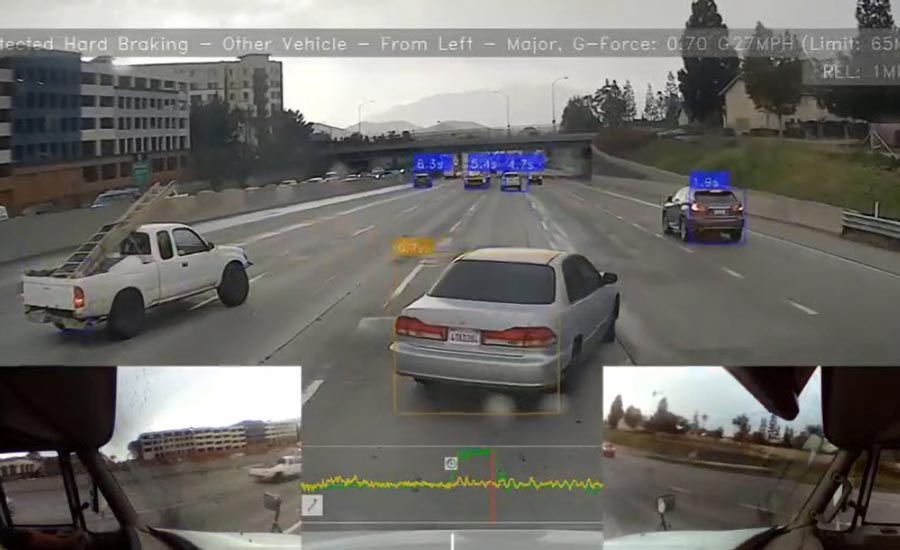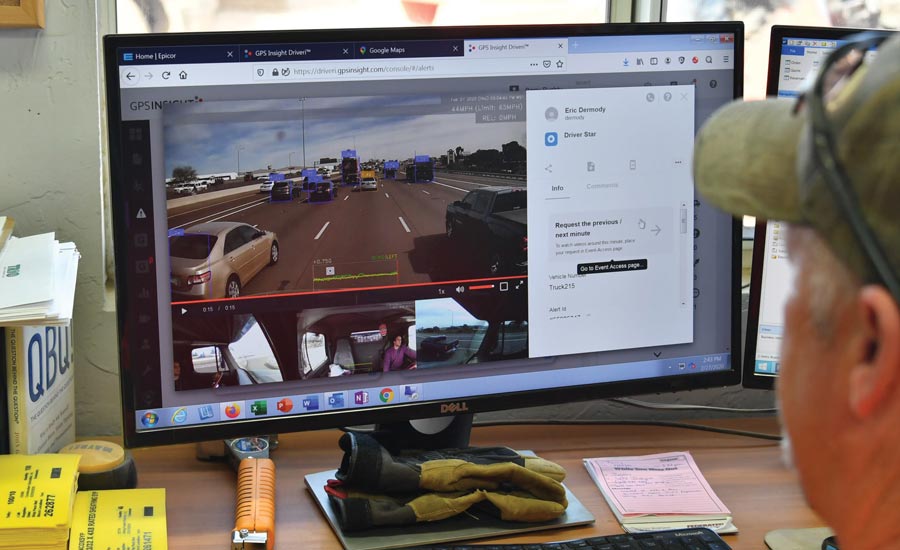The modern company fleet is experiencing a two-part revolution to improve a contractor’s bottom line. On the outside of the truck, the goal is boosting revenue through marketing, thanks to fresh thinking and truck wrap capabilities that revamp what “normal” looks like.
Inside the truck, the name of the game is lowering driving-related expenses through improved monitoring technology. Those strategies have more of an impact on the technicians and their workday, though, creating more potential for resistance.
For owners, the competition to provide these services is getting crowded, too, and vendors offer different combinations of software, AI, GPS, and/or video to wade through.
What makes it worth the effort to contemplate the latest wave of safety-related options, any of which may annoy some hard-to-find employees along the way? Kevin Aries, head of global product success at Verizon Connect, outlined his company’s assessment of savings based on its customer experiences:
- 49% reduction in maintenance costs.
- 36% reduction in fuel costs.
- 22% reduction in accident-related costs.
- 13% reduction in labor costs.
Throw in improved safety for employees and the general public (aka “potential customer base”), and that might warrant a second look.
What’s New in Improved Driving
Aries listed some of the behaviors and data that such systems often shed light on: mileage and after-hours mileage, hard braking, hard acceleration, excessive speed above the posted limit, and seatbelt usage. Verizon Connect blends GPS, IoT, and electronic logging device capabilities.
Andrew Chermark, founder of GPS tracking and management company Smart Fleet, added that today’s options are increasingly plug-and-play. The feedback doesn’t have to be all stick and no carrot, either. Once installed, Chermark explained, owners and fleet managers can use the technology not only to understand each individual’s driving but to reward good drivers with electronic gift cards to companies like Amazon, Starbucks, and Walmart.
As for actual usage, reality has become remarkably advanced. Chermark describes how video telematics can provide in-cab coaching for best practices and tips.
“When a driver takes his or her eyes off the road for more than two seconds, audible tones emit from the camera to alert driver to prevent a distracted driving incident. Most drivers see this as a helpful tool.”
Most of the upside around these products for a company might be internal, but not all of them.
“The new normal in transportation is overcommunication, transparency, and complete visibility to build better customer relationships and experience,” Aries said.
To that end, he explained, companies using telematics with GPS can see where vehicles are in real time on a live map. That can make for easier and more accurate updates to customers (or shifting technician schedules) when needed.

Ryan Driscoll, vice president of marketing for GPS Insight, further encouraged contractors to focus not on everything a product can do, but on what the contractor can do as a result.
“Every telematics provider provides data,” he said. “The difference is those that can turn data into insights — action insights. Most service businesses don’t have data analysts, so it is critical that the technology deliver clean, clear, actionable information.”
Joe Boyle is CEO of TRUCE, a solution that attacks driving quality and safety from an entirely different angle. TRUCE is an app that sits on an employee’s mobile device. It works by automatically switching the device to protected mode depending on the context, such as when an employee is driving a company vehicle.
“Once in a protected mode, TRUCE temporarily suppresses any app or feature, including any alerts or notifications, that are deemed distracting according to company policy,” Bruce said.
“This happens automatically as soon as the employee starts driving, but when the vehicle is stopped, their device reverts back to normal operation.”
This strategy tackles a narrower focus — distracted driving, primarily. It also circumvents the behavior-recording-evaluation-feedback loop and the time it requires by eliminating the opportunity for phone-related risky driving in the first place.
“They put their phone in the cradle or they leave it in their pocket because they know they cannot chat, they cannot text, they can’t look up that next order while they are driving,” Boyle said.
In that sense, the TRUCE approach is different enough that it could conceivably be used not instead of but alongside other options. Boyle stated that TRUCE typically generates a 30% to 40% reduction in accidents on its own within the first year.
Driver Privacy, Driver Protection
No matter which variation a contractor might use, not every employee will like the idea. Offerings have progressed over the years from straightforward GPS vehicle tracking to dash cams facing outward, and more recently to dash cams pointed at the driver and offering advice.
Driscoll sees any employee pushback as natural enough but transitional. Owners heard similar feedback when GPS tracking was introduced, and now that is commonplace. Resistance stems less often from the actual product than the difference from what a given individual is used to.
“Age certainly plays a role,” Driscoll said. “Younger employees have grown up with technology and smartphones and therefore are far more accepting of any fleet technology out of the gate.”
Verizon Connect’s Aries echoed that younger workers show less concern, given their comfort with “photo- and video-centric media where they’re accustomed to showing their locations and activities.”
Setting age aside, he sees new employees in general as more willing to embrace new technology and to challenge the status quo.
Smart Fleet’s Chermark suggests that concerns about privacy can be redirected to how the technology can directly benefit the drivers.
“For techs with dash cameras, it helps protect them from false claims and getting stuck in a ‘he said, she said’ situation.”
The dash footage can be easily retrieved to support drivers in the event of an accident, he said, and drivers do not have to passively rely on the product.
“Dash cams have a button press feature that allows drivers to record unsafe driving of a vehicle near them,” Chermark continued. That tool alone can allow drivers to exonerate themselves, should something happen.
Again, TRUCE’s phone-specific focus gives it a different tack in navigating privacy concerns. It does not record an employee or track and report their location, striking its own mix of pro-safety, pro-privacy elements.
“TRUCE simply enforces company policies,” Boyle said, “and only in those specific situations where the policies are supposed to be enforced.”
Driscoll acknowledged that “You’ll hear many of them say ‘it’s Big Brother’ or ‘how would you like a camera recording everything you do at your desk?’”
“Honestly,” he countered, “we’ve never heard of a four-desk pileup closing a highway for four hours or sending anyone to the hospital, so it’s not much of a comparison.”
The Big Payback
Even employees who are not excited at the prospect of closer monitoring can understand the purely financial appeal for owners, with benefits across several aspects of the business.
Obvious positives of GPS- and video-related services include the chance to see and optimize routing efficiencies. Contractors also stand a good chance of reducing their fleet insurance premiums by implementing safety-related solutions and informing their insurance providers. It can get lost in the modern bells and whistles, but GPS still helps owners retrieve stolen vehicles, too.
Less obviously, most of today’s solutions can find ways to save on fuel costs. Reducing idling time decreases consumption. The logical reduction in speeding and/or hard acceleration can improve gas mileage.
GPS Insight’s Driscoll noted that the technology can even discourage fraud.
“Integrating fuel cards with GPS data can detect possible instances of fuel card fraud by tracking vehicle information as well as the amount of fuel purchased,” he said. “For example, if more gallons are pumped than the vehicle can hold, someone may be using your fuel card to fuel non-company vehicles.”
Finally, the more involved products may be able to preserve the bottom line by keeping a closer eye on the vehicle itself. As Driscoll observed, a driver vehicle inspection process improves communications with the maintenance team.
Furthermore, diagnostic trouble codes can help managers identify and deal with developing problems before they lead to complete failure — the same dynamic that more and more contractors are embracing to increase HVAC service efficiency and reduce costs for their own customers.
How To Steer The Conversation
Nobody starts an HVAC contracting business to lecture people about their driving. Nobody starts an HVAC contracting business to lose money (or worse) because of an employee’s bad driving, either.

What to do?
Ryan Driscoll, vice president of marketing for GPS Insight, shared the story of how one customer handled the arrival of a new smart camera solution called Driveri® with his team.
With two days of driver insights in hand, the manager had meetings with each driver individually, using the coaching module that keeps profiles for each driver and tags events that need to be discussed.
“Let me introduce you to yourself,” the manager told them. He emphasized a few key points with the drivers:
- How they drive at work is also likely how they drive with their families.
- He doesn’t have time or interest in monitoring them constantly.
- The only time he would watch them is if Driveri indicated a safety event.
The manager said that no manager has time to idly peer in on drivers without a reason. He only reviews footage when Driveri notifies him about a possible violation. He emphasized this to drivers from the start: “I will only see what’s created by you.” After these meetings, the drivers quickly reduced their triggered safety events by 91%.



Report Abusive Comment